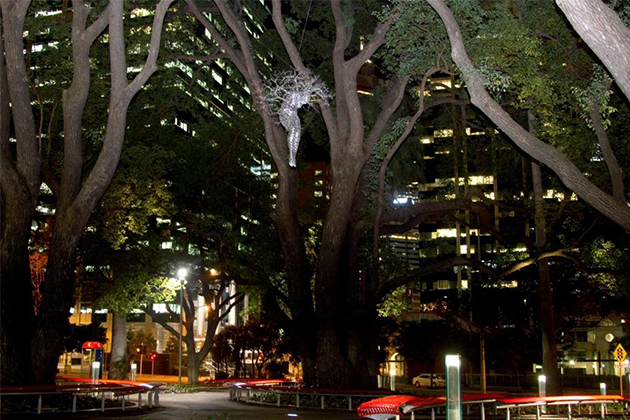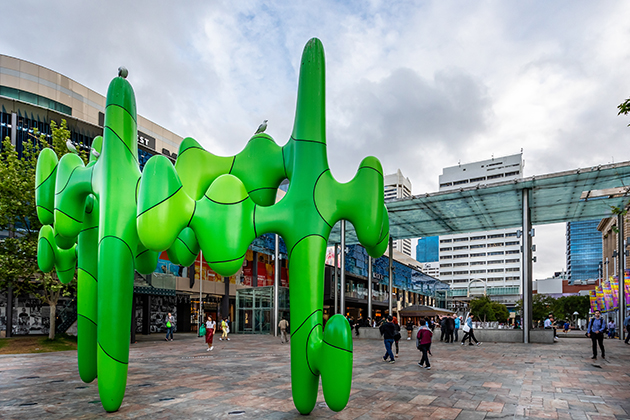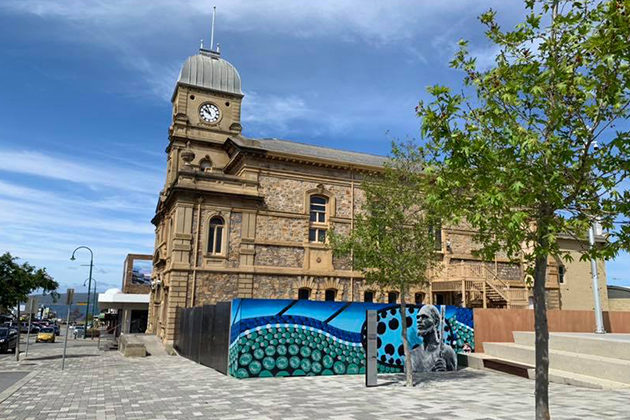13 July, 2020 By: Wendy Caccetta
Any visitor taking a break from city life in Florence Hummerston Reserve, a small green space on the corner of St George’s Terrace and Mount Street, will be rewarded if they cast their eyes upwards.
Among the tree canopy sits the Tree Spirit, an ethereal and beautiful sculpture by Western Australian artist Simon Gilby. It is an unexpected and rewarding find in a tiny city Eden.
Western Australia has amassed an impressive collection of public art under the State’s Percent for Art scheme, particularly in the last decade.
The scheme began in 1989 and requires up to one percent of big construction budgets be spent on artworks. In recent years it has gained momentum.
Now, post COVID-19 lockdown, it’s set for a further boom as some communities look to support their local artists, cheer themselves up and mark the extraordinary times we are living through.
Spontaneous community art, like children’s paintings of rainbows on pavements and in windows, has also bloomed and become an unofficial sign of hope.
RELATED: How WA communities stayed connected during COVID-19 »

Reflecting who we are
In the City of Vincent, which includes the suburbs of Leederville, Mount Lawley, North Perth and Mount Hawthorn, the local council is using half a million dollars, accumulated under Percent for Art scheme, to pay local artists to produce new works.
Vincent Mayor Emma Cole says they are expected to be a mix of smaller grants and later, higher value commissions.
For starters, the council announced in July that $151,000 would fund 16 new community projects reflecting COVID-19 experiences from sculptures to dance, film, literature, murals, music and performance art.
Cole says Vincent was the first local government to embrace Percent for Art in 1998.

“Art is thought provoking, people have strong reactions to it,” she says. “For example I’m sitting in my office and looking at the big blue head by Ken Sealey who is a Highgate local.
“We love that artwork and occasionally, with Ken’s consent, we dress it up and put things on it and make it fun as well.
“Then we have our murals and some people say murals shouldn’t be the only art form and we’re very conscious of that. We have sculptural pieces too. Some of them are quite fun like the robots in North Perth and the upside-down lampshades in Leederville.
“So it is something we definitely embrace and we see strong value about our character. It reflects who we are as a community and it gives us space for expression and for people to enjoy art wherever they are. It doesn’t have to be in a gallery.”
Cole says the citizen art that appeared during the COVID-19 pandemic has also added to the area.
“We’ve been very excited to see the rainbows pop up across the City of Vincent and on front fences,” she says.
“We do have a lot of residents now who are engaging in having murals on their front walls and we love to see that. We love to see people taking that up and seeing the value in adding it to their own personal space even when it’s facing out to the public realm. That’s very welcome here.”
Keeping public art on track
WA Government agency Metronet, which is managing extensions to Perth’s rail network, is also set to add to the art boom.
Metronet managing director Anthony Kannis says they want new stations and precincts to have distinct identities, making them more enjoyable for commuters. They will be inspired by Aboriginal and local culture and landscape.
“Public art will form an integral part of up to 18 new and redeveloped stations across the rail network,” he says. “There will also be a feature work at the Bellevue Rail Depot where the Midland line ends.”
Urban designer Peter Ciemitis, of firm Robertsday, says public art in Perth has grown substantially in recent years as local councils have adopted Percent for Art policies. He says public art contributes to a sense of place.
“It helps to provide ‘legibility’, it’s a vague planners’ term but what it means is that it makes a building or a place more memorable, exactly in the same way people might say ‘I’ll meet you in the city next to the cactus’,” he says. “You know immediately what they are talking about.
“Or you might say ‘Go up the street and turn right at the red hair pin’. You know you are talking about Lake Street and Newcastle Street.
“It helps to build a legibility where often it’s hard to make buildings and other places quite so memorable.
“Another thing it contributes is, if there is a need to it can hide unsightly parts of buildings, perhaps carparks etcetera.
"It can also provide a lot of inspiration for what we aspire to or what the future might hold.” Ciemitis says inspirational pieces include James Angus’ Grow Your Own — better known as the green cactus in Perth’s Forrest Place — and Gilby’s Tree Spirit.

He says our art compares favourably with that of other places.
“Certainly we are seeing such a proliferation of public art in our communities and centres that you just don’t see at a similar level in other major cities,” he says.
“In Perth, particularly around the central area, you might come across two or three or four public art pieces on one street block, whereas elsewhere in Australia or overseas you might need to walk a kilometre or more.”
Our outdoor galleries
Lynda Dorrington, executive director of WA-based arts organisation FORM, says they are working on a new, big public art project designed to stimulate tourism in 2021 – which is still under wraps.
“WA now has an abundance of unique and beautiful public artwork,” she says. “From giant murals by world-class street artists on grain silos spanning the wheatbelt and Great Southern, to Sir Antony Gormley’s Inside Australia sculptures at the Lake Ballard salt pan in the Goldfields; to Laurel Nannup's First Contact at Elizabeth Quay, one of the first major Noongar public artworks in Perth’s CBD; or the collection of 1500 contemporary artworks by mostly WA artists recently installed at Crown Towers.”
In the Great Southern, Albany, too, is playing its part in the art revolution.
“A lot of our public artwork can be found along the main strip in the CBD called York Street where both local and visiting artists are on display around the clock,” says Albany mayor Dennis Wellington.
“Our public art trail map is a fantastic tool that takes the viewer on a journey across Albany to experience our Leafy Dragon Silo, Alison Hartman Gardens’ Mokare statue, the Albany Public Library’s Sleeping Giant and all that the public art along York Street has to offer.”
In 2018-19 the city hosted English-Australian installation artist Bruce Munro’s celebrated Field of Light, a large-scale work that illuminated the Avenue of Honour at Mt Clarence in honour of the Anzacs.

The artist's voice
WA artist and sculptor Simon Gilby says public art is important because it interrupts the routine of everyday life — sometimes simply by being in the way.
“What I love about public art, including public art that I don’t like, is that it interrupts me and it reminds me that my life and my humanity are my own again,” he says.
His Tree Spirit has been part of Florence Hummerston Reserve for eight years. Other artworks are designed to slowly dissolve and live on in the memories of those who see them, such as Entitlement 1 at Bathers Beach in Fremantle in 2015.
Gilby says the global pandemic has forced a re-think of our humanity and values, something art will reflect.
“I’m really interested in it as a metaphor and how it is physically changing us, changing our behaviour etcetera.
“But what it might also do, and I kind of hope for this, is that maybe the community will turn to look to art to reckon with those things.”
Enjoy this story? Get more of the same delivered to your inbox. Sign up to For the Better eNews.
Image credit: City of Vincent, City of Albany and Simon Gilby.
